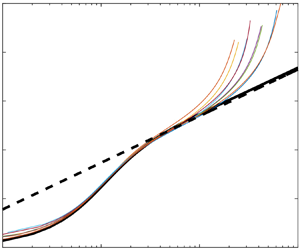Article contents
Velocity and temperature scalings leading to compressible laws of the wall
Published online by Cambridge University Press: 22 December 2023
Abstract

We exploit the similarity between the mean momentum equation and the mean energy equation and derive transformations for mean temperature profiles in compressible wall-bounded flows. In contrast to prior studies that rely on the strong Reynolds analogy and the presumed similarity between the instantaneous and mean velocity and temperature signals, the discussion in this paper involves the Farve-averaged equations only. We establish that the compressible momentum and energy equations can be made identical to their incompressible counterparts under appropriate normalizations and coordinate transformations. Two types of transformations are explored for illustration purposes: Van Driest (VD)-type transformations and semi-local-type or Trettel–Larsson (TL)-type transformations. In our derivations, it becomes clear that VD-type velocity and temperature transformations hold exclusively within the logarithmic layer. On the other hand, TL-type transformations extend their applicability to incorporate wall-damping effects, at least in principle. Each type of transformation serves its distinct purpose and has its applicable range. However, it is noteworthy that while VD-type transformations can be assessed using measurements obtained from laboratory experiments, TL-type transformations necessitate viscosity and density information typically accessible only through numerical simulations. Finally, we justify the omission of the turbulent kinetic energy transfer term, a term that is unclosed, in the energy equation. This omission leads to closed-form temperature transformations that are valid for both adiabatic and isothermal walls.
- Type
- JFM Papers
- Information
- Copyright
- © The Author(s), 2023. Published by Cambridge University Press
References
- 6
- Cited by



